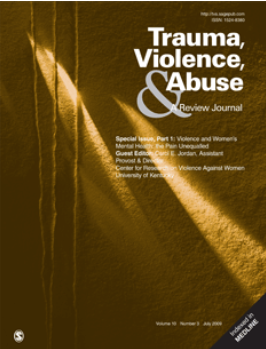The Help-Seeking Behavior of Victims of Image-Based Sexual Harassment and Abuse: A Scoping Review
IF 5.4
1区 社会学
Q1 CRIMINOLOGY & PENOLOGY
引用次数: 0
Abstract
Image-based sexual harassment and abuse (IBSHA) has recently gained scientific attention. To date, research has primarily focused on victim characteristics and impact, while little specific empirical research exists on victims’ help-seeking behavior, including barriers and facilitators to seeking support. The aim of this scoping review was to examine the current state of literature on IBSHA victims’ help-seeking behavior and barriers and facilitators to seeking support. Seven electronic bibliographic databases were searched up to June 2023 to identify relevant literature. Inclusion criteria consisted of (1) English or Dutch language, (2) original empirical data, (3) studying one or more forms of IBSHA, (4) victim sample, and (5) addressing help-seeking behavior, and/or factors encouraging or discouraging help-seeking. The scoping review was conducted following the Preferred Reporting Items for Systematic Reviews and Meta-Analysis Protocols extension for scoping reviews. In total, 81 articles were included. Varying definitions of IBSHA, sample sizes, and populations complicated the drawing of general conclusions. The research was primarily conducted in English-speaking Western countries with a majority of young, White, heterosexual, and women samples. Prevalence rates of help-seeking strongly varied. Multiple sources of informal and formal support were identified, including friends, family, social media platforms, and police. Informal support appeared preferred. Articles identified several barriers to help-seeking including shame, (fear of) negative social responses and negative expectations of formal support, and facilitators, including desire for justice and takedown of non-consensually shared images. Research on IBSHA is growing rapidly. The field would benefit from further research focused on help-seeking with diverse samples, standardized measures, and intersectionality. Recommendations for policy and practice are provided.基于形象的性骚扰和性虐待受害者的求助行为:范围审查
基于图像的性骚扰和性虐待(IBSHA)最近得到了科学界的关注。迄今为止,研究主要集中在受害者特征和影响方面,而关于受害者求助行为(包括寻求支持的障碍和促进因素)的具体实证研究却很少。本范围综述旨在研究有关 IBSHA 受害者寻求帮助的行为以及寻求支持的障碍和促进因素的文献现状。我们检索了截至 2023 年 6 月的七个电子文献数据库,以确定相关文献。纳入标准包括:(1) 英语或荷兰语;(2) 原始经验数据;(3) 研究一种或多种形式的 IBSHA;(4) 受害者样本;(5) 涉及求助行为和/或鼓励或阻碍求助的因素。范围界定综述是按照范围界定综述的《系统综述和元分析协议首选报告项目》扩展版进行的。共纳入了 81 篇文章。由于 IBSHA 的定义、样本大小和研究人群各不相同,因此难以得出一般性结论。研究主要在讲英语的西方国家进行,以年轻、白人、异性恋和女性样本居多。寻求帮助的流行率差异很大。研究发现了多种非正式和正式的支持来源,包括朋友、家人、社交媒体平台和警方。非正式支持似乎更受青睐。文章指出了寻求帮助的几种障碍,包括羞耻感、(害怕)负面的社会反应和对正规支持的负面期望,以及促进因素,包括对正义的渴望和对未经同意共享图片的删除。有关 IBSHA 的研究正在迅速发展。该领域将受益于以不同样本、标准化测量方法和交叉性为重点的求助方面的进一步研究。本文还提供了政策和实践建议。
本文章由计算机程序翻译,如有差异,请以英文原文为准。
求助全文
约1分钟内获得全文
求助全文
来源期刊

Trauma Violence & Abuse
Multiple-
CiteScore
13.60
自引率
7.80%
发文量
131
期刊介绍:
Trauma, Violence, & Abuse is devoted to organizing, synthesizing, and expanding knowledge on all force of trauma, abuse, and violence. This peer-reviewed journal is practitioner oriented and will publish only reviews of research, conceptual or theoretical articles, and law review articles. Trauma, Violence, & Abuse is dedicated to professionals and advanced students in clinical training who work with any form of trauma, abuse, and violence. It is intended to compile knowledge that clearly affects practice, policy, and research.
 求助内容:
求助内容: 应助结果提醒方式:
应助结果提醒方式:


